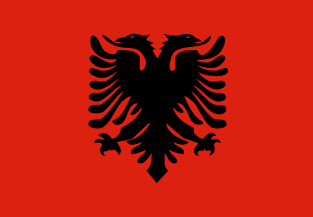Albania


Continent – Europe
Region – Central Europe, not EU member
Size – 27,400 km²
Geography – North, east and south mountainous, west coastal
Language – Albanian, Greek
Religion – 70% Islam, 20% Albanian Orthodox, 10% Roman Catholic
Monetary Unit – Lek
Natural Resources – Natural gas, petroleum, coal, bauxite, chromite, copper, iron ore, nickel salt, timber
Agriculture – wheat, corn, potatoes, vegetables, fruits, sugar beets, grapes; meat, dairy products
Industry – food processing, textiles, and clothing; lumber, oil, cement, chemicals, mining, basic metals, hydropower

Neighbouring Countries – Serbia, Montenegro, Macedonia, Greece
Population – 3,600,523 (2007)
Population Growth Rate – 0.5%
Average Life Expectancy – 77.6
Capital City – Tirana (population 353,400)
Highest Mountain – Maja e Korabit (2,764 m)
Longest River – Drin (335 km)
Climate – Coastal – cool, wet winters 2°C to 14°C and hot, dry summers 16°C to 32°C – Inland – cooler and wetter
Yearly Rainfall – 137 cm approx
Plant Life – Mountain Regions – oak, conifer, pine, and beach trees; Coastal Regions – Mediterranean plants
Animal Life – wolf, fox, jackal, ferret, brown bear, pine marten, wild cat, lynx, weasel, roe deer, chamois, wild boar, otter, goat
Bird Life – 350+ bird species, including – grouse, woodcock, snipe, pelicans
Aquatic Life – sardine, mullet, red mullet, carp, speckled trout
Harvard Reference for this page:
Heather Y Wheeler. (2015). Albania. Available: https://www.naturalhistoryonthenet.com/Facts_Figures/Country_Facts/albania.htm. Last accessed Monday, July 18, 2016
Facts and Figures Pages
